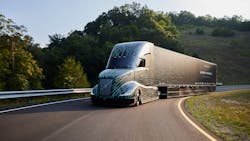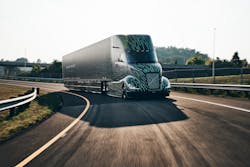Volvo SuperTruck 2 uses aerodynamics, advanced engineering to top 12 mpg
A wholly reimagined, lighter tractor body that is more aerodynamic—including a dramatically redesigned cab with a wraparound windshield— and even features a micro-hybrid system are among the ways that Volvo Trucks North America achieved greater freight efficiency with its latest SuperTruck.
The OEM shows off the potential trucking can achieve when efficiency technologies are pushed to the edge. Tasked by the U.S. Department of Energy to improve freight efficiency, the diesel-powered Volvo SuperTruck 2 topped 12 miles per gallon, according to the OEM. VTNA showed off the futuristic-looking long-haul truck online this week before its public debut during American Trucking Associations' 2023 Management Conference & Exhibition in Austin, Texas, from Oct. 14-17.
"Our focus on SuperTruck 2 from the beginning was building the truck around freight efficiency for real-world application," Eric Bond, Volvo Trucks' principal engineer for the project, told FleetOwner. "For our final verification of our targets, we could have selected a 'perfect scenario' location to go test the truck—flat roads, no traffic, low wind or tailwind—but we didn't do that."
See also: How this truck driver reached 10 MPG
Bond said the SuperTruck 2 was built in Greensboro, North Carolina, and validated on Interstate 73. "This is one of the same roads that we test and evaluate our current commercially available product line when we're looking for product improvements, and it is representative of our customer duty cycles. We wanted to see how this truck would do with elevation change, variable traffic that was out of our control, and even in these conditions, we're extremely pleased that we exceeded our internal stretch goal of 120% freight efficiency."
Bond said the tractor-trailer averaged 12.38 mpg over the complete validations cycle, which included traffic, varying grade, terrain, and running at posted highway speed limits. VTNA reported a 134% freight efficiency increase compared to the DOE-set 2009 baseline. "The 2009 baseline was a 6x4 tractor, standard trailer, that achieved a freight efficiency of 100 ton-miles per gallon," Bond explained. "SuperTruck 2 achieved 234 ton-miles per gallon."
DOE's SuperTruck program challenges OEMs
The SuperTruck 2 program is a public-private partnership in which the DOE tasked OEMs to achieve 100% freight efficiency improvement over their 2009 baselines. Rival truck makers Peterbilt, Freightliner, and International showed off their Super Truck 2 versions earlier this year.
"Partnering with the DOE for the SuperTruck program provides an exciting opportunity to push the technology envelope to see what's technically possible for heavy-duty transportation and which solutions can be scaled into production, but equally important, which solutions don't work for scaled production," VTNA President Peter Voorhoeve said. "We are extremely proud of the accomplishments of our advanced engineering team who worked on SuperTruck 2. A program of this magnitude pushes the limits in every possible area—creativity, problem-solving, feasibility, and innovation, to which we feel we did successfully. Some of the technologies on SuperTruck 2 will most certainly shape the future of trucking and change everything we once thought possible."
The DOE's SuperTruck 2 program funds research and development to improve the efficiency of heavy-duty Class 8 long-haul tractor-trailers. The program aims to accelerate the growth of cost-effective advanced efficiency technologies that are not currently on the market. For SuperTruck 2, all participating OEMs were asked to demonstrate more than 100% improvement in vehicle freight efficiency (ton-miles per gallon).
"Our strategy for decarbonization relies heavily on the rapid transition to and adoption of zero-emission vehicles," Bond said. "The lessons learned from SuperTruck 2 regarding aerodynamics and lightweighting will be directly applicable to our next generation of battery-electric trucks to increase efficiency, range, payload, and thereby productivity and value to the customer."
A deeper look at how Volvo built the SuperTruck 2
For Volvo Trucks' SuperTruck 2, it focused on advanced aerodynamics to optimize fuel efficiency. It started with a wedge-shaped cab with a raked and wraparound windshield, a front end designed around a downsized cooling package, and a fully aerodynamic trailer with gap fairings, skirts, and a boat tail. In addition, it featured an adjustable ride height. Volvo also replaced the traditional hood and cab-mounted mirrors with a streamlined camera monitoring system to reduce the drag by more than 4%.
"SuperTruck 2 demonstrated significant aerodynamic gains from an entirely reimagined Body-in-White," Bond told FleetOwner. "This is a learning we can incorporate into our future cab updates. We have regulatory pressures to reduce tailpipe CO2 emissions at both powertrain and vehicle levels. We cannot meet the vehicle level targets without reducing aerodynamic loads, even if we develop and offer the most efficient powertrain possible in a truck."
See also: Volvo leaning on global EV experience to help fleets electrifyThe tractor-trailer combination was designed to smoothly displace air with minimal resistance, resulting in 50% lower drag than Volvo Trucks' 2009 baseline. This represents a roughly 20% improvement in aerodynamic drag over Volvo Trucks' first SuperTruck.
Around two-thirds of the drag reduction in SuperTruck 1 over the 2009 baseline came from trailer aerodynamic treatments—optimizing the skirt and boat tail. Since SuperTruck 2 also features an optimized trailer skirt and boat tail, most of its aerodynamic gains over the first SuperTruck are attributed to the new cab design. SuperTruck 2 demonstrated the potential for significant aerodynamic improvements by changing the Body-in-White.
"The importance of trailer aerodynamics is another aspect we have highlighted with both SuperTruck demonstrators," Bond explained. "This will help fleets reduce fuel consumption from ICE-based tractors and increase the range of their BEV tractors, improving overall productivity."
In addition to the aerodynamic advancements, engineers implemented several weight reduction strategies to achieve a significantly reduced curb weight of 27,000 lbs. for the combined truck and the trailer. Volvo Trucks chose to utilize a 4x2 configuration, uncommon in the U.S. but frequently utilized in Europe, using fewer axles for the same payload.
The truck was designed to be applied to a 6x2 or 6x4 configuration, but that was not part of the specific demonstrator validation for this program. The shorter cab design is lightweight and paired with an aluminum chassis with a lightweight optimized drive axle system with a single composite driveshaft.
Volvo Trucks worked with the project partner trailer manufacturer Wabash National to incorporate a custom, lightweight aerodynamic trailer with an optimized full truck and trailer aerodynamic shape to appear as one seamless unit. Volvo also worked with the project partner tire manufacturer Michelin to include lightweight, smaller 19.5-inch advanced low-friction tires on both the SuperTruck 2 and its custom trailer.
With a focus on the driving environment, the Volvo Trucks SuperTruck 2 features a 48-volt micro-hybrid system that acts as a generator with an integrated starter. This provides power for driver comfort features, including an all-electric HVAC system that allows drivers to avoid idling during rest breaks and still have power for amenities.
Applying SuperTruck 2 technology to real world
"While SuperTruck 2 is a one-off vehicle, some of its aerodynamic features can still be brought into our future cab platforms where we will offer a range of cab lengths," Bond said when asked what solutions could be scaled into future VTNA offerings. "While the rear door entry may not be feasible in such a platform, the wedge shape of the cab in plan view, with a raked and wraparound windshield, could be industrialized."
The mirror-less camera monitoring system, which uses high-definition cameras and monitors instead of traditional side-view mirrors, is another set of technology that could be used today.
"It provides significant drag reduction when it replaces the traditional hood and cab-mounted side mirrors," Bond explained. "However, regulatory changes are required before we can eliminate traditional mirrors. In the short term, it's possible to offer a hybrid setup where a regulatory-compliant mirror supplements a fully functional CMS."
Voorhoeve noted that the project team focused on real-world driving conditions for testing. "This is the most aerodynamic and efficient truck Volvo has built to date, and we achieved a freight efficiency that demonstrates the potential for technology innovations to be developed commercially," he said. "Our engineers have already begun implementing some of the learnings from SuperTruck 2 into our future truck models. The future of trucks is just around the corner."
About the Author
Josh Fisher
Editor-in-Chief
Editor-in-Chief Josh Fisher has been with FleetOwner since 2017. He covers everything from modern fleet management to operational efficiency, artificial intelligence, autonomous trucking, alternative fuels and powertrains, regulations, and emerging transportation technology. Based in Maryland, he writes the Lane Shift Ahead column about the changing North American transportation landscape.


